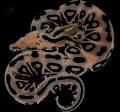» Site Navigation

1 members and 1,237 guests
Most users ever online was 47,180, 07-16-2025 at 05:30 PM.
» Today's Birthdays

» Stats

Members: 75,945
Threads: 249,142
Posts: 2,572,362
Top Poster: JLC (31,651)
|
-
Registered User


Good reading material?
Hello again!
I was wondering if anyone knew of some good books on the care of eggs and hatchlings. I have been pouring over the net and have found alot of good info right here. I am looking for specifics on hatchling care and husbandry. I want to get into hobby breeding but i want to be as knowledgable as i can before i take on such a project!
Thanks again,
Bill
 Protect our rights!!
Protect our rights!!
My Crew  
4.7 Great Ball Pythons!!
0.0.1 Boa constrictor ~ Petie
-
-
Re: Good reading material?
Bill, VPI's book is awesome and McCurley's book is a good one as well.
-
The Following User Says Thank You to Dave Green For This Useful Post:
-
Re: Good reading material?
 Originally Posted by David Green

Bill, VPI's book is awesome and McCurley's book is a good one as well.
Thats what I would say
-
-
Re: Good reading material?
"Incubation of Reptile Eggs" by Gunther Kohler
This book stops right after hatching is complete--no information on hatchling care.
However, it will tell you everything you could want to know about reptile eggs, and has an index of incubation data for a HUGE number of species (temperatures, humidity, time frames, temp-sexing, etc).
This is a really accessible but professional book that I think any herpetoculturist working with multiple species should have on the shelf (right next to "Understanding Reptile Parasites").
If you're looking for JUST ball python information, the McCurley book is good. I can sum up caring for hatchlings in one paragraph here, though:
Give them tight fitting hides, keep them in small bins, keep the temperatures high, and wait 1 week after they shed before you offer food. Before the first shed, make sure you keep that humidity high, up at 80% or more. Offer live rat pups first. If those don't work, wait 3 days, offer again. Try at least 3 times with rat pups, then try hopper mice. Don't start to worry until 3 weeks past first shed, then you can consider things like filling the bin with crumpled paper and feeding late at night, using a fuzzy mouse, or even assist-feeding if all else fails. 96% of the time assist-feeding won't be necessary, but when it is, it almost always works. Once they're eating regularly, it's simple. Care is just like the adults, but remember that their tolerance for environmental variation is lower--keep temperatures and humidity stable and correct, and keep them eating regularly.
Last edited by WingedWolfPsion; 02-14-2010 at 05:29 PM.
-
The Following User Says Thank You to WingedWolfPsion For This Useful Post:
Turbo Serpent (02-14-2010)
-
Re: Good reading material?
 Originally Posted by WingedWolfPsion

If you're looking for JUST ball python information, the McCurley book is good. I can sum up caring for hatchlings in one paragraph here, though:
Give them tight fitting hides, keep them in small bins, keep the temperatures high, and wait 1 week after they shed before you offer food. Before the first shed, make sure you keep that humidity high, up at 80% or more. Offer live rat pups first. If those don't work, wait 3 days, offer again. Try at least 3 times with rat pups, then try hopper mice. Don't start to worry until 3 weeks past first shed, then you can consider things like filling the bin with crumpled paper and feeding late at night, using a fuzzy mouse, or even assist-feeding if all else fails. 96% of the time assist-feeding won't be necessary, but when it is, it almost always works. Once they're eating regularly, it's simple. Care is just like the adults, but remember that their tolerance for environmental variation is lower--keep temperatures and humidity stable and correct, and keep them eating regularly.
Couldn't have put this better myself. 
I own the Kevin McCurley's book and it has a lot of info from basic husbandry to genetics.
1.0: Honey Bee | Lesser | Banana Pastel Enchi | Clown 66% Het Albino
0.1: Kingpin | x2 Mojave | Super Pastel HGW | Albino | Sterling Mojave Pinstripe | GHI Pewter | Pastel Het Clown | Sable 66% Het Clown
-
 Posting Permissions
Posting Permissions
- You may not post new threads
- You may not post replies
- You may not post attachments
- You may not edit your posts
-
Forum Rules
|











 Reply With Quote
Reply With Quote





